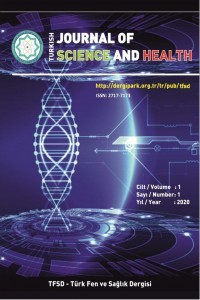Investigating the Relationship Between Cyberchondria Level and Perceived Stress in Young Adults
Investigating the Relationship Between Cyberchondria Level and Perceived Stress in Young Adults
Cyberchondria, Young Adults, Perceived Stress,
___
- Altındiş, S., İnci, MB., Aslan, FG. et al. (2018). An Evaluation of cyberchondria levels and related factors in university employees. Sakarya Med J, 8(2), 359-370.
- Barke, A., Bleichhardt, G., Rief, W. et al. (2016). The Cyberchondria Severity Scale (CSS): German validation and development of a short form. International Journal of Behavioral Medicine, 23(5), 595–605. https://doi.org/10.1007/s12529-016-9549-8.
- Batı, AH., Mandıracıoglu, A., Govsa, F. et al. (2018). Health anxiety and cyberchondria among Ege University health science students. Nurse Education Today, 71, 169-173. https://doi.org/10.1016/j.nedt.2018.09.029
- Batıgün, AD., Gör, N., Kömürcü, B. et al. (2018). Cyberchondria Scale (CS): Development, validity and reliability study. Dusunen Adam The Journal of Psychiatry and Neurological Sciences, 31, 148-162. https://doi.org/10.5350/DAJPN2018310203
- Cohen, S., Kamarch, T., Mermelstein, R. (1983). A global measure of perceived stress Journal of Health and Social Behavior, 24, 385-396
- Dagar, D., Kakodkar, P., Shetiya, SH. (2019). Evaluating the cyberchondria construct among computer engineering 2019 students in Pune (India) Using Cyberchondria Severity Scale (CSS-15). Indian J Occup Environ Med, 23(3), 117–120. https://doi.org/10.4103/ijoem.IJOEM_217_19
- Doherty-Torstrick, ER., Walton, KE., Fallon BB. (2016). Cyberchondria: Parsing Health Anxiety From Online Behavior. Psychosomatics, 57(4), 390-400. https://doi.org/10.1016/j.psym.2016.02.002
- Elciyar, K., Taşçı, D. (2017). Application of Cyberchondria Severity Scale to the students of Anadolu University Communication Faculty. Abant Journal of Cultural Studies, 2(4), 57-70.
- Ertaş, H., Kıraç, R., Ünal, SN. (2020). Study of cybercondria levels and related factors of Faculty of Health Sciences students. International Journal of Society Researches, 15(23), 1746-1764. https://doi.org/10.26466/opus.616396
- Eskin, M., Harlak, H., Demirkıran, F. et al. (2013). The adaptation of the perceived Stress Scale into Turkish: A reliability and validity analysis. New Symposium Journal, 51(3), 132-140.
- Fergus TA. (2013). Cyberchondria and intolerance of uncertainty: Examining when individuals experience health anxiety in response to internet searches for medical information. Cyberpsychology, Behavior, And Social Networking, 16(10), 735-9. https://doi.org/10.1089/cyber.2012.0671
- Fergus, TA., Spada, MM. (2017). Cyberchondria: Examining relations with problematic ınternet use and metacognitive beliefs. Clin Psychol Psychother, 24(6), 1322-1330. https://doi.org/10.1002/cpp.2102
- Gençer, AG., Karadere, ME., Okumuş, B. et al. (2018). Diagnoses that are not yet included in DSM-5 (Compulsive buying, misophonia, facebook jealousy, pagophagia, cyberchondria, internet addiction). Ç. Hocaoğlu (Ed.), DSM-5'in Yeni Tanıları (s. 87-96). Ankara: Türkiye Klinikleri.
- Gül, Aİ., Özdemir, T., Börekçi, E. (2016). Health anxiety levels in patients admitted to internal medicine outpatient clinic for several times. Journal of Clinical and Analytical Medicine, 7(4), 437-439. https://doi.org/10.4328/JCAM.2951
- Hart, J., Björgvinsson, T. (2010). Health anxiety and hypochondriasis: Description and treatment issues highlighted through a case illustration. Bulletin of the Menninger Clinic, 74(2), 122-140.
- Hocaoğlu, Ç. (2015). A different hypochondriasis: A case report. Journal of Mood Disorders, 5(1), 36-39. https://doi.org/10.5455/jmood.20141119012438
- Jungmann, SM., Brand, S., Kolb, J. et al. (2020). Do Dr. Google and health apps have (comparable) side effects? An experimental study. Clinical Psychological Science, 8(2), 306-317. https://doi.org/10.1177/2167702621989638.
- Jutel, A. (2017). "Dr. Google" and his predecessors. Diagnosis, 4(2), 87-91. https://doi.org/10.1515/dx-2016-0045
- Lupton, D., Maslen, S. (2019). How women use digital technologies for health: Qualitative interview and focus group study. Journal of Medical Internet Research, 21(1), e11481. https://doi.org/10.2196/11481
- Makarla, S., Gopichandran, V., Tondare, D. (2019). Prevalence and correlates of cyberchondria among professionals working in the information technology sector in Chennai, India: A cross-sectional study. J Postgrad Med, 65(2), 87–92. https://doi.org/10.4103/jpgm.JPGM_293_18
- McElroy, E., Shevlin, M. (2014). The development and initial validation of the cyberchondria severity scale (CSS). Journal of Anxiety Disorders, 28(2), 259-265. https://doi.org/10.1016/j.janxdis.2013.12.007
- Rice, RE. (2006). Influences, usage, and outcomes of internet health information searching: Multivariate results from the pew surveys. International Journal Of Medical İnformatics, 75(1), 8-28. https://doi.org/10.1016/j.ijmedinf.2005.07.032
- Singh, K., Brown, R. J. (2016). From headache to tumour: An examination of health anxiety, health-related Internet use and 'query escalation'. Journal of Health Psychology, 21(9), 2008-2020. https://doi.org/10.1177/1359105315569620
- Starcevic, V. (2017). Cyberchondria: Challenges of problematic online searches for health-related information. Psychother Psychosom, 86(3), 129-133. https://doi.org/10.1159/000465525
- Starcevic, V., Berle, D. (2013). Cyberchondria: towards a better understanding of excessive health-related internet use. Expert Rev. Neurother, 13(2), 205-213. https://doi.org/ 10.1586/ern.12.162
- Te Poel F., Baumgartner, SE., Hartmann, T. et al. (2016). Disorders The curious case of cyberchondria: A longitudinal study on thereciprocal relationship between health anxiety and online health information seeking M. Journal of Anxiety Disorders, 43, 32–40. https://doi.org/10.1016/j.janxdis.2016.07.009
- Uzun, SU., Zencir, M. (2018). Reliability and validity study of the Turkish version of Cyberchondria Severity Scale. Current Psychology, 1-7. https://doi.org/10.1007/s12144-018-0001-x
- Wijesinghe, CA., Liyanage, ULNS., Kapugama, KGCL. et al. (2019). Muddling by googling Cyberchondria among outpatient attendees of two hospitals in Sri Lanka. J Psychiatry, 10(1), 11-15. https://doi.org/10.4038/sljpsyc.v10i1.8202
- Başlangıç: 2020
- Yayıncı: Ümit Muhammet KOÇYİĞİT
İlknur ENİNANÇ, Tuğba HERGÜNER
Effect of Wheat Germ Oil on Wound Healing: An In Vitro Study in Fibroblast Cells
Muhammed GÖMEÇ, Gülnihal İPEK, Ayşegül ÖZTÜRK, Deniz ŞAHİN İNAN
Evaluation of Menstrual Irregularities and Dysmenorrhea in University Students
Çiğdem GÜN KAKAŞÇI, Dilek COŞKUNER POTUR
Özden BASKAN, Zeynep SOY, Muammer ÇORUM, Emre BASKAN
Relationship of Nursing Students’ Anxiety Level in the Covid-19 Pandemic with E-Learning
Sevinç KÖSE, Papatya KARAKURT, Meryem FIRAT
Funda EVCİLİ, Fatma TOK YILDIZ
Thyroid hormones as a potential prognostic markers for neonates with hypoxic ischemic encephalopathy
Gaffari TUNÇ, Nurullah ÇELİK, Fatih KILIÇBAY, Mahmut EKİCİ
In vitro bioactivity and gene silencing effect of shRNA-VEGF loaded chitosan nanoparticles
Emrullah DÜNDAR, Emine Nur ÇORUM
The Immediate Effects of Rigid Taping on Physical Performance in Women with Hallux Valgus Deformity
